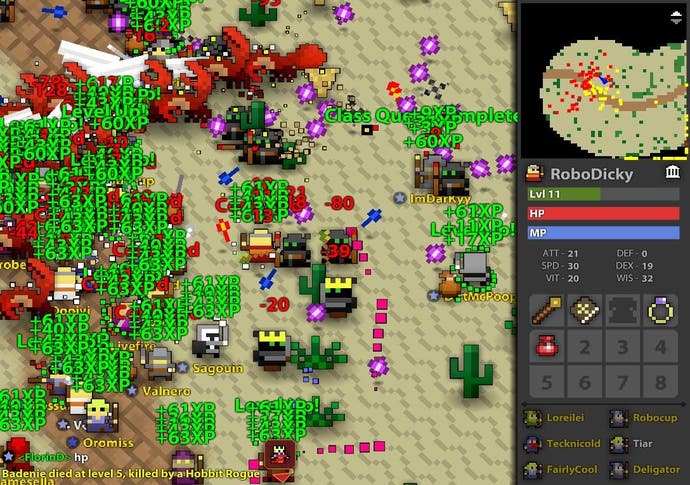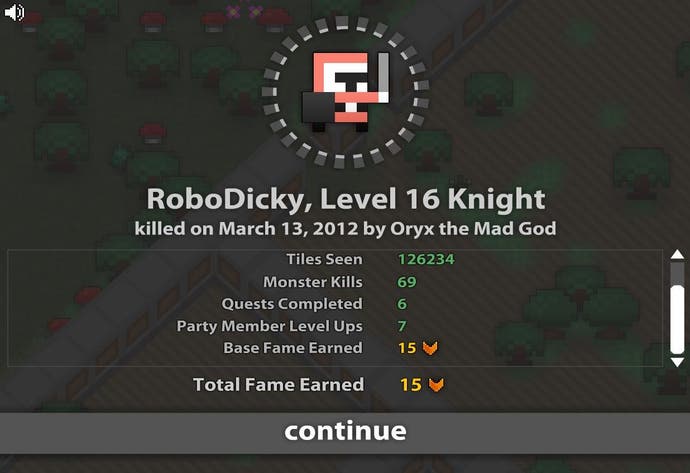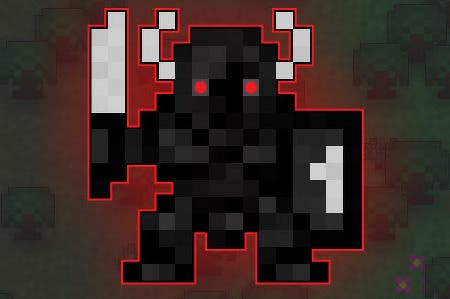Realm of the Mad God Review
All aboard!
There are no trains in Realm of the Mad God - well, not the kind that go along tracks anyway. Yet rarely a minute passes without some reference in the chat window that every player can see. "Train anywhere?" "Choo Choo?" "Where train pls?" And then comes the glorious moment when a soul stops to type "TRAIN HERE," and all the cool kids teleport to their location.
A train in Realm of the Mad God is a big bunch of players that find a road, and then follow that road on its never-ending loop around the world. Auto-fire is turned on, everyone's moving at a slightly different speed, and every single enemy that's in front or to the side of this force of nature is obliterated in an instant.

A train is not, strictly speaking, part of Mad God's rules. It exploits them, slotting perfectly into the system as well as being tremendous fun. Killing enemies as part of a group rewards each member of that group with XP - and this figure is not divided, so every player involved gets the full amount. So players form trains to level up at an extraordinarily fast rate. The game can barely handle it at times, especially when you hit a gigantic gaggle of beasties that are obliterated in seconds, the frame-rate slowing to a crawl as multitudes of green numbers and 'level up!' notices fill the screen.
Being in a train is amazing. CHOO CHOO!
Trains are so common in Mad God because levelling up and permanent death are constants. You begin as one of 13 classes, the Wizard, with the remainder unlocking as you achieve certain in-game targets - for example, hitting the level cap of 20. The game is an unusual crossbreed of genres, mixing an MMO-lite quest and levelling structure with the instant combat of a twin-stick shooter (it can be played with pad or keyboard and mouse). Then it speeds everything up.
The game starts in the Nexus, a hub where you can buy and store gear, hang out in guildhalls, and trade with other players. It's also a refuge. One of Mad God's key features is the ability to instantly warp back to the Nexus at any time. When your character dies, they're gone forever, and so is anything they're carrying. One of the first things you should do is hotkey the 'return to Nexus' command to the key you can hit with the absolute minimum of thought, because it's perhaps the most important command in the game.
From the Nexus there will be openings to randomly-generated worlds, each of which holds a maximum of 85 players. These are filled with everything from low-level snakes and pirates to terrifying monstrosities that can blind, paralyse, slow, one-shot, and generally make mincemeat of unwary adventurers. If you forego the joys of a train, then it's about following the on-screen quest arrow to fight a boss appropriate to your level (the arrow also comes with a helpful picture of the boss, so you always know what to look for) and gradually climbing the ranks.

Impromptu little bands of players form around these, sharing the same objectives and all that sweet XP, and levelling in this manner is speedy and fun (though not quite the breakneck joyride of a you-know-what). Enemies drop loot, and each class has four class-specific gear slots that can be gradually filled with better and better stuff. As you're levelling, your character isn't just becoming more powerful, but their weapons and equipment start to improve in sync; you might get a scroll increasing the area-of-effect damage of a Wizard's spell, or a ring making your Rogue move at nearly twice his original speed.
To go from level 1 to 20 takes around 15 to 20 minutes in a train, and around 30 to 40 by the 'proper' route. The only disadvantage of trains, incidentally, is that it's difficult to stop and search all the dropped loot without losing track of your buddies. But even then, Mad God has a feature for you. You can teleport to any other player in the world instantly (with a cooldown of around five seconds), meaning that upon entering a new world it's easy to find a band that are roughly equivalent in level, warp over and join the fun. It's a simple little feature, and a great one.
As you reach the higher levels, the monsters become fearsome, and Mad God's pixel art really comes into its own. Puce-yellow Medusas fire jagged green bolts in deadly arcs, squat and thunderous golems spew out cascades of bubbles that surround entire parties as they're trying to dodge faster missiles, and ghostly soldiers engorge themselves and their arrows to gigantic sizes as they try to defend a long-dead king.

The art for the character classes is also superb, not just because they look cool, but because the distinctions are obvious at a glance and you can instantly tell what kind of abilities make up your current party. In its early stages, Mad God's combat is a simple matter of moving and shooting with competence, but by the time you've started taking down the guardians of Oryx (the eponymous Mad God) then MMO tactics come to the fore: buffers, debuffers, tanks, healers, damage-dealers. Skills that were useful simply for getting by suddenly need to be used as part of a team - and if you should happen to reach Oryx's castle, achieved by killing all of his bosses in any given world, every player has a role.
It's the perfect game for people who love the idea of raiding, but can't afford to invest the time all MMOs require before the really good stuff - and all for free.
It's a remarkable miniaturisation of a complex system that captures the feel of much more elaborate takes - and, with that ever-present threat of permanent death hanging over you, it has a delicious cutting edge. I haven't beaten Oryx yet, but that bastard's taken me down several times. Of course, I blame my companions.
When your character finally dies, as they will, their total accomplishments (level reached, gods killed, gear acquired) are translated into 'fame', an in-game currency that can be traded at the Nexus. For your first few hours, anything above 20 fame is an achievement. After that, it seems like a failure.
There is one more aspect of Mad God that really impresses. The game's been available in a browser previously, but this review is sparked by its release as a free-to-play title on Steam, and it really gets free-to-play right. So many developers base this business model around hobbling the free players, when in fact success stories show that free players are the most important component of the player-base - if they're not there, then the paying punters have no context in which to feel special.

Everything in Mad God is achievable without spending a penny. You'll never need to pay to enjoy this game to its fullest, you'll just need to put the hours in. Everything that can be bought with realm gold (the purchasable in-game currency) is nice to have, sure, but it's either cosmetic stuff like a snazzy checked dress for your huntress, or an in-game pet, or in the most extreme case a key that gives you a one-time-only door to one of the many 'special' instances that can also be found while adventuring. Buy one of these keys, incidentally, and you can take a whole band of players in with you to hunt down the loot. Sure, there are things it's nice to have - extra storage space in the Nexus, or an extra character slot. But that's like complaining a free steak doesn't come with Béarnaise sauce.
Realm of the Mad God is superb. It's a game that can be played in 30-minute bursts or sessions that stretch long into the night, and its balance of instant gratification and long-term pay-off is beautifully done. It's the perfect game for people who love the idea of raiding, but can't afford to invest the time all MMOs require before the really good stuff - and all for free.
One go and you'll get it. One train and you're hooked.

